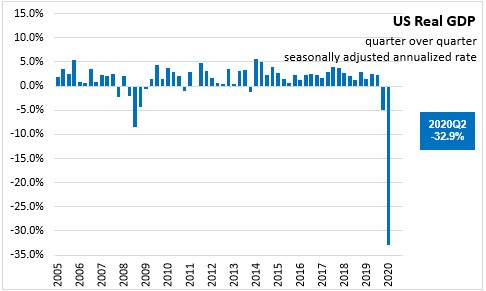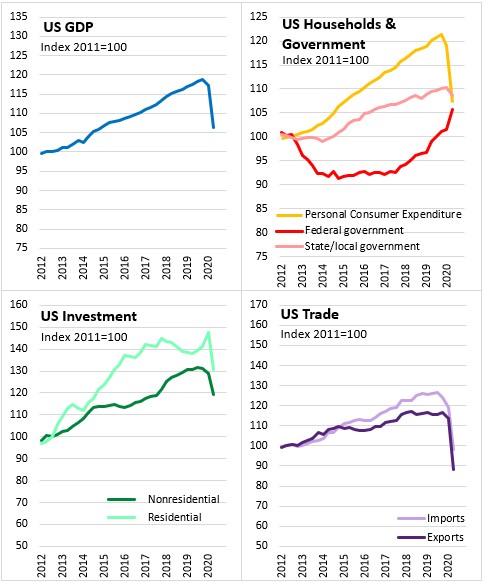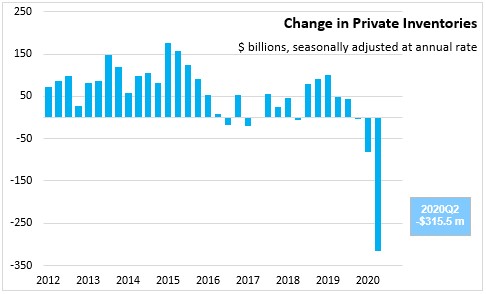The Economics and Statistics Division maintains archives of previous publications for accountability purposes, but makes no updates to keep these documents current with the latest data revisions from Statistics Canada. As a result, information in older documents may not be accurate. Please exercise caution when referring to older documents. For the latest information and historical data, please contact the individual listed to the right.
<--- Return to Archive
For additional information relating to this article, please contact:
July 30, 2020US GDP 2020 Q2 (ADVANCE ESTIMATE) 
The US economy declined 32.9 per cent (seasonally adjusted annualized rate, chained 2012 dollars) in Q2 2020, according to the advance estimate by the US Bureau of Economic Analysis (BEA). The annualized growth rate was -5.0 per cent in the first quarter of 2020. The decrease in real GDP reflected decreases in personal consumption expenditures (PCE), exports, private inventory investment, non-residential fixed investment, residential fixed investment, and state and local government spending. These declines were partly offset by an increase in federal government spending. Imports, which are a subtraction in the calculation of GDP, decreased.
BEA noted that the decline in second quarter GDP reflected policy responses to COVID-19, with "stay-at-home" orders issued in March and April partially lifted in some areas of the country in May and June, and government pandemic assistance payments distributed to households and businesses. This led to rapid shifts in activity, as businesses and schools continued remote work and consumers and businesses cancelled, restricted, or redirected their spending. BEA also noted that the full economic effects of the COVID-19 pandemic cannot be quantified in the GDP estimate for the second quarter of 2020 because the impacts are generally embedded in source data and cannot be separately identified.
Personal consumption expenditure growth declined 34.6 per cent in Q2 (annualized rate) compared to a decrease of 6.9 per cent in the previous quarter. Expenditure on goods decreased 11.3 per cent on declines in both durable and non-durable goods. Expenditure on services declined 43.5 per cent. Non-residential investment declined 27.0 per cent with declines in structures, equipment, and intellectual property. Residential investment declined 38.7 per cent. Exports declined 64.1 per cent with lower goods exports and services exports. Imports declined 53.4 per cent. US nominal GDP declined 34.3 per cent in Q2, compared to -3.4 per cent growth reported in Q1. The personal consumption expenditure price index decreased 1.9 per cent, following a 1.3 per cent increase in the previous quarter.


A seasonally adjusted annualized rate shows what the percent change would be if the quarterly rate continued for four quarters. It is computed by compounding the quarterly rate for four quarters. Reporting annualized rates facilitates comparability between annual and quarterly growth, but can exaggerate change when series are volatile. The COVID-19 shocks of do not indicate a contraction of US GDP by 32.9 per cent in Q2. It would take four quarters of compounded contraction at the same pace as reported in Q2 to reduce US GDP by 32.9 per cent. Real GDP in Q2 contracted 9.5 per compared to Q1 2020.
Source: US Bureau of Economic Analysis
<--- Return to Archive